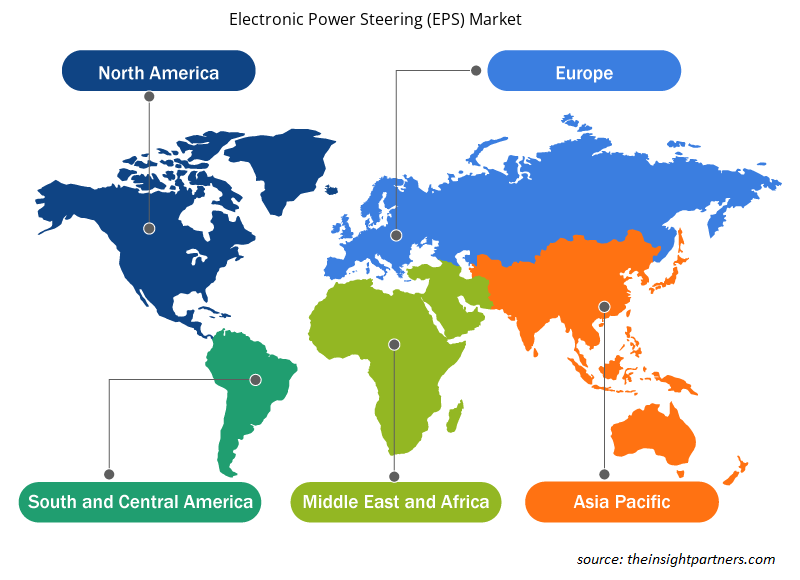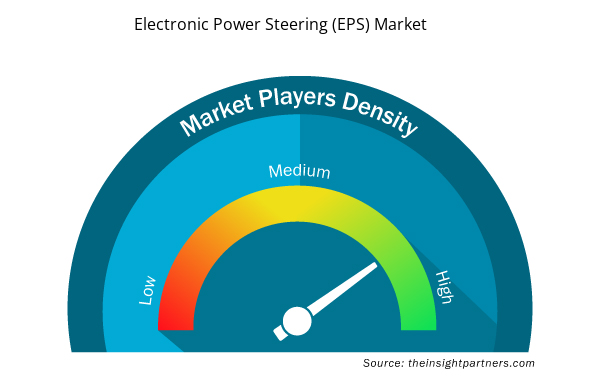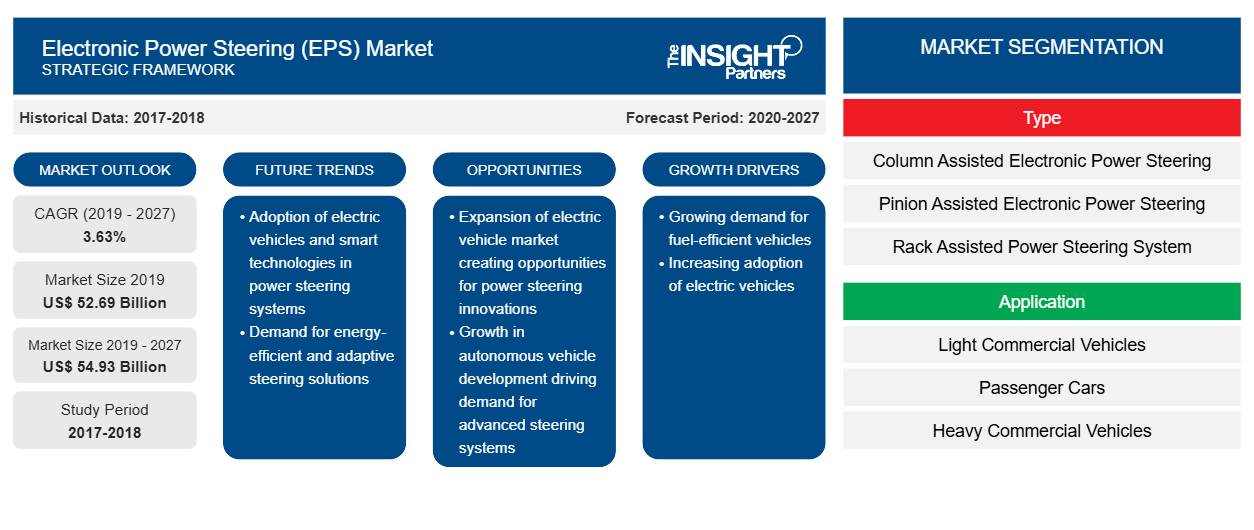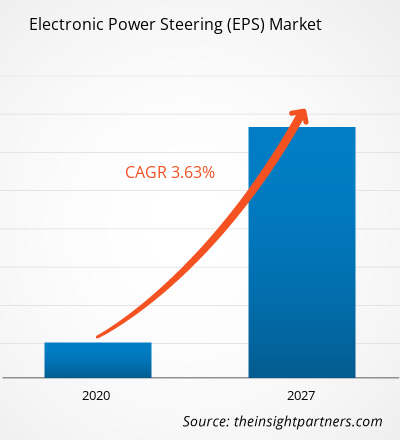Nel 2019, il mercato globale del servosterzo elettronico era stimato in 52.692,31 milioni di dollari USA e si prevede che crescerà a un CAGR del 3,63% nel periodo di previsione dal 2020 al 2027.
Il mercato del servosterzo elettronico è ampiamente segmentato in cinque regioni principali: Nord America, Europa, APAC, MEA e SAM. Il mercato globale è stato dominato dalla regione APAC nel 2019, che ha rappresentato quasi la metà del mercato totale a causa di una maggiore domanda di sistemi di servosterzo elettronico. Fattori come la più ampia adozione di auto premium, berline e SUV tra la popolazione APAC contribuiscono in modo significativo alla quota di mercato più significativa della regione. Inoltre, Ford Motor Company of Australia Limited, Toyota Motor Corporation Australia Limited, Mitsubishi Motors Australia Ltd. (MMAL), General Motors Holden, Isuzu Australia Limited, Volkswagen Group Australia Pty Ltd. e Hyundai Commercial Vehicles Australia sono alcuni dei noti produttori di veicoli commerciali nel paese. Tutti questi produttori richiedono l'integrazione dell'EPS nelle auto per soddisfare la domanda emergente dei clienti. Inoltre, si prevede che l'incremento delle attività di produzione automobilistica, la crescente domanda di veicoli elettrici e la crescente attenzione dei produttori di EPS nell'offrire prodotti a basso costo e ad alta efficienza guideranno la crescita del mercato EPS nel resto dei paesi dell'Asia Pacifica durante il periodo di previsione.
Approfondimenti di mercato: mercato del servosterzo elettronico
Crescente vendita di auto di lusso in Cina
Personalizza questo report in base alle tue esigenze
Riceverai la personalizzazione gratuita di qualsiasi report, comprese parti di questo report, o analisi a livello nazionale, pacchetto dati Excel, oltre a usufruire di grandi offerte e sconti per start-up e università
- Scopri le principali tendenze di mercato in questo rapporto.Questo campione GRATUITO includerà analisi di dati che spaziano dalle tendenze di mercato alle stime e alle previsioni.
Nel 2019, la Cina ha rappresentato quasi 21,4 milioni di veicoli. Il paese è il più grande produttore e il più grande mercato per le vendite di auto a livello mondiale. Tuttavia, nel 2019, le vendite complessive di auto sono diminuite di circa l'1,9%, ma la domanda di SUV e berline di lusso è aumentata con un tasso rispettivamente del 3,5% e del 18,8% rispetto al 2018. Tutti i principali OEM di veicoli di lusso nel paese, tra cui BMW, Mercedes-Benz e Audi, hanno riportato cifre positive a novembre 2019. Insieme all'aumento delle vendite, anche lo scenario di mercato è cambiato rapidamente. Nella generazione precedente, i consumatori erano soliti acquistare veicoli di lusso principalmente per rivelare il loro status sociale, ma la nuova generazione di acquirenti progressivamente sofisticata sta acquistando automobili di lusso per la richiesta di lusso e tecnologie intelligenti. Secondo uno studio condotto dalla China Association of Automobile Manufacturers, le donne svolgono un ruolo significativo nel mercato cinese delle auto di lusso. Questo sondaggio ha affermato che quando scelgono un modello di veicolo, le donne danno più valore alle caratteristiche di sicurezza, al comfort e allo stile esterno, rispetto alle qualità preferite dai loro colleghi maschi, come la tecnologia del gruppo propulsore, i marchi premium riconosciuti socialmente e i modelli più grandi. I fattori sopra menzionati guideranno la domanda di integrazione dell'EPS nelle berline e nei SUV.
Impatto del COVID-19
L'industria dei semiconduttori e quella automobilistica sono tra le vittime del COVID-19 e, dall'inizio del 2020, hanno registrato un trend in calo. Con l'imposizione del lockdown in tutti i paesi del Nord America, Europa e Asia, le industrie hanno assistito a un'esperienza sconvolgente. L'industria automobilistica richiede un numero significativo di manodopera umana e, al contrario, il virus COVID-19 si sta diffondendo attraverso il coinvolgimento umano, il settore non è in grado di funzionare correttamente. Il trend in calo nell'industria automobilistica e dei semiconduttori sta riflettendo un impatto negativo sul mercato del servosterzo elettronico.
Tipo Segmento Insights
In base al tipo, il segmento del servosterzo elettronico assistito dalla colonna ha dominato il mercato globale del servosterzo elettronico nel 2019. Il sistema di servosterzo elettronico sta gradualmente sostituendo il sistema di sterzo convenzionale nei veicoli moderni. Il vantaggio principale dell'utilizzo del sistema di servosterzo elettronico è la capacità di ridurre al minimo il consumo di energia. Il sistema di servosterzo elettronico assistito dalla colonna (C-EPS) è uno dei tipi di sistema di servosterzo elettronico.
Informazioni sul segmento del tipo di veicolo
In base al tipo di veicolo, il segmento delle autovetture ha detenuto la quota maggiore nel mercato globale del servosterzo elettronico nel 2019. Le autovetture sono veicoli di trasporto con non più di otto posti. A causa del peggioramento delle condizioni meteorologiche e della qualità dell'aria in paesi come Bangladesh, Pakistan, Mongolia, Afghanistan, India, le persone stanno adottando carburanti alternativi e tecnologie correlate nelle loro autovetture. Le autovetture possono essere suddivise in berline, hatchback e SUV o MUV. La domanda di veicoli per passeggeri è in aumento con l'aumento del reddito pro capite e la necessità di lusso.
Gli operatori del mercato si concentrano su innovazioni e sviluppi di nuovi prodotti integrando tecnologie e funzionalità avanzate nei loro prodotti per competere con i concorrenti.
- Nel 2019, Nexteer Automotive ha annunciato il traguardo di produzione di 60 milioni di sistemi di servosterzo elettrico (EPS) a livello globale. Questi potrebbero essere utilizzati in veicoli che vanno dalle piccole auto ai grandi camion. I sistemi di servosterzo elettrico aumentano l'efficienza del carburante del 6% e le emissioni di CO2 di 8 grammi al km.
- Nel 2018, Robert Bosch GmbH ha installato i sistemi di assistenza alla guida in autostrada Bosch per la funzione di guida parzialmente automatizzata, installati su tutti i veicoli della gamma Maserati MY 2018. Insieme a ciò, il servosterzo elettrico Bosch (EPS), un'altra innovazione introdotta sulla gamma Maserati MY2018, contribuisce all'implementazione della tecnologia di assistenza alla guida in autostrada e di altri sistemi avanzati di assistenza alla guida.
- Nel 2018, Hyundai Mobis ha sviluppato un sistema di servosterzo elettrico che sfrutta due circuiti elettronici durante la guida autonoma per mantenere le normali capacità di sterzata in qualsiasi circostanza.
Servosterzo elettronico
Approfondimenti regionali sul mercato dello sterzo elettronico (EPS)
Le tendenze regionali e i fattori che influenzano il mercato dell'Electronic Power Steering (EPS) durante il periodo di previsione sono stati ampiamente spiegati dagli analisti di Insight Partners. Questa sezione discute anche i segmenti di mercato dell'Electronic Power Steering (EPS) e la geografia in Nord America, Europa, Asia Pacifico, Medio Oriente e Africa e Sud e Centro America.

- Ottieni i dati specifici regionali per il mercato dello sterzo elettronico (EPS)
Ambito del rapporto di mercato sullo sterzo elettronico (EPS)
| Attributo del report | Dettagli |
|---|---|
| Dimensioni del mercato nel 2019 | 52,69 miliardi di dollari USA |
| Dimensioni del mercato entro il 2027 | 54,93 miliardi di dollari USA |
| CAGR globale (2019 - 2027) | 3,63% |
| Dati storici | 2017-2018 |
| Periodo di previsione | 2020-2027 |
| Segmenti coperti | Per tipo
|
| Regioni e Paesi coperti | America del Nord
|
| Leader di mercato e profili aziendali chiave |
|
Densità degli attori del mercato dello sterzo elettronico (EPS): comprendere il suo impatto sulle dinamiche aziendali
Il mercato del servosterzo elettronico (EPS) sta crescendo rapidamente, spinto dalla crescente domanda degli utenti finali dovuta a fattori quali l'evoluzione delle preferenze dei consumatori, i progressi tecnologici e una maggiore consapevolezza dei vantaggi del prodotto. Con l'aumento della domanda, le aziende stanno ampliando le loro offerte, innovando per soddisfare le esigenze dei consumatori e capitalizzando sulle tendenze emergenti, il che alimenta ulteriormente la crescita del mercato.
La densità degli operatori di mercato si riferisce alla distribuzione di aziende o società che operano in un particolare mercato o settore. Indica quanti concorrenti (operatori di mercato) sono presenti in un dato spazio di mercato in relazione alle sue dimensioni o al valore di mercato totale.
Le principali aziende che operano nel mercato del servosterzo elettronico (EPS) sono:
- Hyundai Mobis
- Società JTEKT
- Mitsubishi Electric Corporation
- Autoveicoli Nexteer
- NSK Ltd.
Disclaimer : le aziende elencate sopra non sono classificate secondo un ordine particolare.

- Ottieni una panoramica dei principali attori del mercato dello sterzo elettronico (EPS)
Il mercato globale del servosterzo elettronico è stato segmentato come segue:
Mercato del servosterzo elettronico – Per tipo
- Servosterzo elettronico assistito dalla colonna
- Sterzo elettrico assistito da pignone
- Sistema di servosterzo assistito a cremagliera
- Servosterzo idraulico elettronico
Mercato del servosterzo elettronico – Per tipo di veicolo
- Veicoli commerciali leggeri
- Autovetture passeggeri
- Veicoli commerciali pesanti
Mercato dello sterzo elettronico - Per regione
America del Nord
- NOI
- Canada
- Messico
Europa
- Francia
- Germania
- Italia
- Regno Unito
- Russia
- Resto d'Europa
Asia Pacifico (APAC)
- Cina
- India
- Corea del Sud
- Giappone
- Australia
- Resto dell'APAC
Medio Oriente e Africa (MEA)
- Sudafrica
- Arabia Saudita
- Emirati Arabi Uniti
- Resto del MEA
America del Sud (SAM)
- Brasile
- Argentina
- Resto del SAM
Mercato dello sterzo elettronico – Profili aziendali
- Hyundai Mobis
- Società JTEKT
- Mitsubishi Electric Corporation
- Autoveicoli Nexteer
- NSK Ltd.
- Robert Bosch GmbH
- Società Showa
- La Mando Corporation
- ThyssenKrupp AG
- ZF Friedrichshafen AG
- Analisi storica (2 anni), anno base, previsione (7 anni) con CAGR
- Analisi PEST e SWOT
- Valore/volume delle dimensioni del mercato - Globale, regionale, nazionale
- Industria e panorama competitivo
- Set di dati Excel



Report Coverage
Revenue forecast, Company Analysis, Industry landscape, Growth factors, and Trends

Segment Covered
This text is related
to segments covered.

Regional Scope
North America, Europe, Asia Pacific, Middle East & Africa, South & Central America

Country Scope
This text is related
to country scope.
Domande frequenti
The electronic power steering (EPS) market is led by passenger cars segment with highest share and is expected to dominate in the forecast period. Passenger cars are the transport vehicles with not more than eight seats. Due to the worsening weather and air quality in countries, such as Bangladesh, Pakistan, Mongolia, Afghanistan, India, people are adopting alternative fuel and related technologies in their passenger cars. Passenger cars can be divided into sedan, hatchback, and SUV or MUV. The demand for passenger vehicles is increasing with a rise in per capita income and need for luxury. The electronic power steering system is linked to the vehicle control unit.
There is an increase in adoption of buses and trucks, specifically for logistics and public transportation purposes, across the globe. In Asia, Oceania, and Europe, the public transportation is used more as compared to private transportation, whereas in North America, transportation is mainly through private vehicles. Growing population in urban areas is demanding the increasing public transportation with the improvement in existing transportation infrastructure is proving to be insufficient. The OEMs across the globe are now focusing on reducing the global carbon footprint, therefore, boosting the usage of electric vehicles is anticipated to offer ample growth opportunities for the global electronic power steering (EPS) market players.
Rising adoption of autonomous driving worldwide is one of the major factors boosting the adoption of steer-by-wire systems in the vehicles. SbW is enhancing the driving experience as well as safety. The SbW technology is currently experiencing a constant surge in development as well as demand. The higher levels of autonomous driving require uninterrupted communication, redundant power supply, and steering rack. Moreover, the SbW enhances the safety with the help of driver assistance systems. It also eliminates the intermediate steering shaft and thus, reduces the risk of injury to the driver from mechanical steering components by augmenting the passive safety in the vehicle.
Trends and growth analysis reports related to Automotive and Transportation : READ MORE..
The List of Companies - Electronic Power Steering Market
- Hyundai Mobis
- JTEKT Corporation
- Mitsubishi Electric Corporation
- Nexteer Automotive
- NSK Ltd.
- Robert Bosch GmbH
- Showa Corporation
- The Mando Corporation
- ThyssenKrupp AG
- ZF Friedrichshafen AG
The Insight Partners performs research in 4 major stages: Data Collection & Secondary Research, Primary Research, Data Analysis and Data Triangulation & Final Review.
- Data Collection and Secondary Research:
As a market research and consulting firm operating from a decade, we have published and advised several client across the globe. First step for any study will start with an assessment of currently available data and insights from existing reports. Further, historical and current market information is collected from Investor Presentations, Annual Reports, SEC Filings, etc., and other information related to company’s performance and market positioning are gathered from Paid Databases (Factiva, Hoovers, and Reuters) and various other publications available in public domain.
Several associations trade associates, technical forums, institutes, societies and organization are accessed to gain technical as well as market related insights through their publications such as research papers, blogs and press releases related to the studies are referred to get cues about the market. Further, white papers, journals, magazines, and other news articles published in last 3 years are scrutinized and analyzed to understand the current market trends.
- Primary Research:
The primarily interview analysis comprise of data obtained from industry participants interview and answers to survey questions gathered by in-house primary team.
For primary research, interviews are conducted with industry experts/CEOs/Marketing Managers/VPs/Subject Matter Experts from both demand and supply side to get a 360-degree view of the market. The primary team conducts several interviews based on the complexity of the markets to understand the various market trends and dynamics which makes research more credible and precise.
A typical research interview fulfils the following functions:
- Provides first-hand information on the market size, market trends, growth trends, competitive landscape, and outlook
- Validates and strengthens in-house secondary research findings
- Develops the analysis team’s expertise and market understanding
Primary research involves email interactions and telephone interviews for each market, category, segment, and sub-segment across geographies. The participants who typically take part in such a process include, but are not limited to:
- Industry participants: VPs, business development managers, market intelligence managers and national sales managers
- Outside experts: Valuation experts, research analysts and key opinion leaders specializing in the electronics and semiconductor industry.
Below is the breakup of our primary respondents by company, designation, and region:

Once we receive the confirmation from primary research sources or primary respondents, we finalize the base year market estimation and forecast the data as per the macroeconomic and microeconomic factors assessed during data collection.
- Data Analysis:
Once data is validated through both secondary as well as primary respondents, we finalize the market estimations by hypothesis formulation and factor analysis at regional and country level.
- Macro-Economic Factor Analysis:
We analyse macroeconomic indicators such the gross domestic product (GDP), increase in the demand for goods and services across industries, technological advancement, regional economic growth, governmental policies, the influence of COVID-19, PEST analysis, and other aspects. This analysis aids in setting benchmarks for various nations/regions and approximating market splits. Additionally, the general trend of the aforementioned components aid in determining the market's development possibilities.
- Country Level Data:
Various factors that are especially aligned to the country are taken into account to determine the market size for a certain area and country, including the presence of vendors, such as headquarters and offices, the country's GDP, demand patterns, and industry growth. To comprehend the market dynamics for the nation, a number of growth variables, inhibitors, application areas, and current market trends are researched. The aforementioned elements aid in determining the country's overall market's growth potential.
- Company Profile:
The “Table of Contents” is formulated by listing and analyzing more than 25 - 30 companies operating in the market ecosystem across geographies. However, we profile only 10 companies as a standard practice in our syndicate reports. These 10 companies comprise leading, emerging, and regional players. Nonetheless, our analysis is not restricted to the 10 listed companies, we also analyze other companies present in the market to develop a holistic view and understand the prevailing trends. The “Company Profiles” section in the report covers key facts, business description, products & services, financial information, SWOT analysis, and key developments. The financial information presented is extracted from the annual reports and official documents of the publicly listed companies. Upon collecting the information for the sections of respective companies, we verify them via various primary sources and then compile the data in respective company profiles. The company level information helps us in deriving the base number as well as in forecasting the market size.
- Developing Base Number:
Aggregation of sales statistics (2020-2022) and macro-economic factor, and other secondary and primary research insights are utilized to arrive at base number and related market shares for 2022. The data gaps are identified in this step and relevant market data is analyzed, collected from paid primary interviews or databases. On finalizing the base year market size, forecasts are developed on the basis of macro-economic, industry and market growth factors and company level analysis.
- Data Triangulation and Final Review:
The market findings and base year market size calculations are validated from supply as well as demand side. Demand side validations are based on macro-economic factor analysis and benchmarks for respective regions and countries. In case of supply side validations, revenues of major companies are estimated (in case not available) based on industry benchmark, approximate number of employees, product portfolio, and primary interviews revenues are gathered. Further revenue from target product/service segment is assessed to avoid overshooting of market statistics. In case of heavy deviations between supply and demand side values, all thes steps are repeated to achieve synchronization.
We follow an iterative model, wherein we share our research findings with Subject Matter Experts (SME’s) and Key Opinion Leaders (KOLs) until consensus view of the market is not formulated – this model negates any drastic deviation in the opinions of experts. Only validated and universally acceptable research findings are quoted in our reports.
We have important check points that we use to validate our research findings – which we call – data triangulation, where we validate the information, we generate from secondary sources with primary interviews and then we re-validate with our internal data bases and Subject matter experts. This comprehensive model enables us to deliver high quality, reliable data in shortest possible time.


 Ottieni un campione gratuito per questo repot
Ottieni un campione gratuito per questo repot